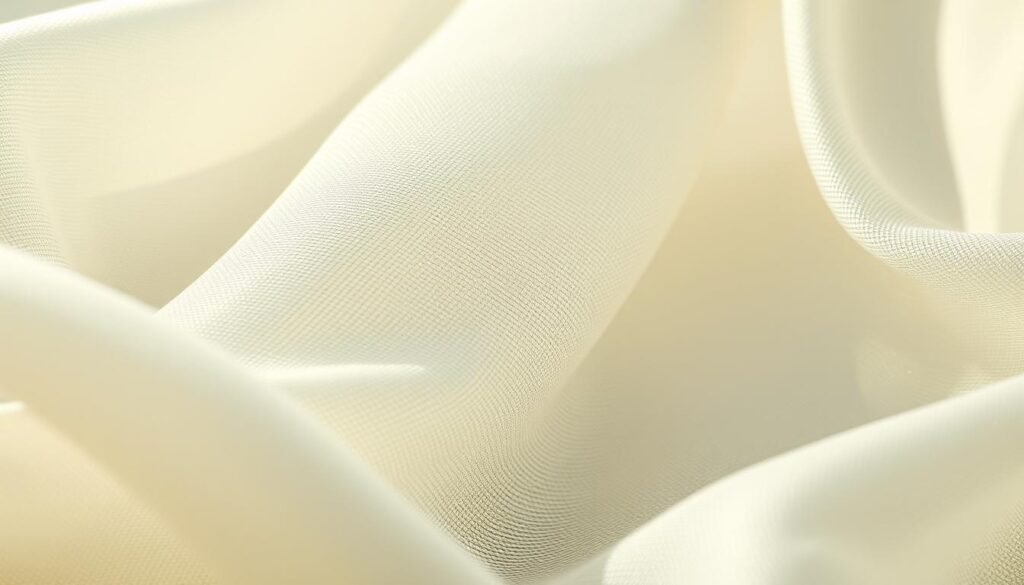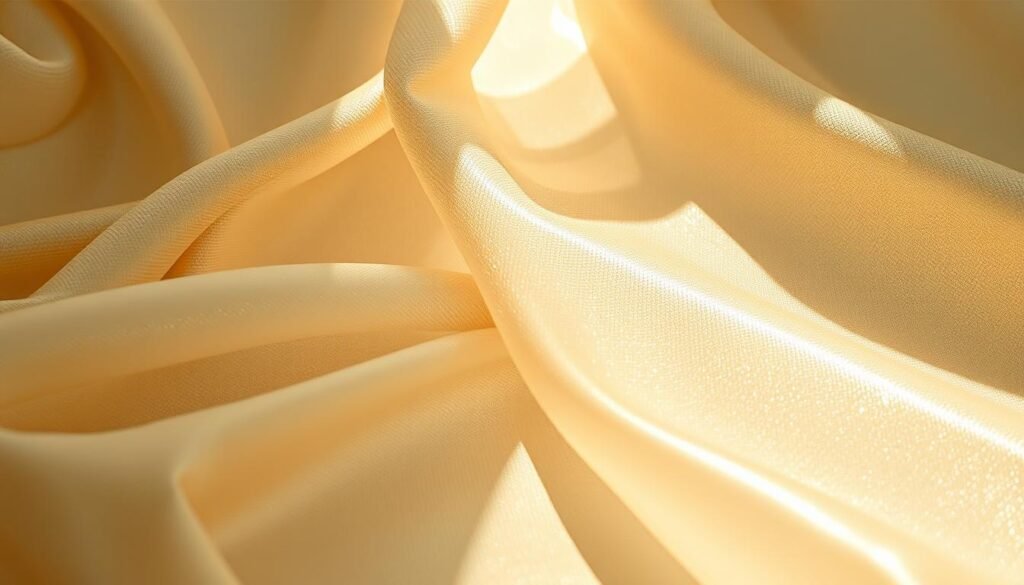Choosing the right fabric is key, especially for clothes that touch your skin. But does silk, a classic and fancy natural fiber, really let air in? Let’s look into the science of silk’s breathability. See why people pick it for staying cool and comfy.
Key Takeaways
- Silk is a highly breathable natural fabric that allows for optimal air circulation and moisture-wicking.
- The unique protein structure of silk fibers enables the fabric to be lightweight, soft, and temperature-regulating.
- Silk’s breathability is essential for maintaining comfort and preventing heat buildup, making it a popular choice for clothing and bedding.
- Compared to synthetic fabrics, silk is a superior choice for its natural breathability and thermoregulatory properties.
- Proper care and maintenance of silk garments can help preserve the fabric’s breathability and longevity.
Silk has been around for centuries, loved for its shiny look and soft touch. It’s known for letting air in and keeping your body temperature just right. Natural fabrics like cotton, linen, and bamboo are top choices for staying cool1. Silk, made from animals, also lets air in well and keeps you cool1. But synthetic fabrics like polyester don’t breathe at all1.
So, why is silk so good at letting air in? It’s all about its special structure and how it works with your body. Let’s explore the science behind silk’s breathability. Discover why it’s a top pick for staying cool and comfy.
What is Breathability in Fabrics?
Fabric breathability means it lets air and moisture through. This keeps us comfortable and controls our body temperature2. Natural materials like cotton, linen, and bamboo are great at letting air in and taking sweat away2. They keep us cool because they’re made to let air through easily2.
Understanding the Importance of Breathable Fabrics
Breathable fabrics are key for staying cool and avoiding getting too hot3. Cotton is a top choice for clothes and bedding because it absorbs sweat well3. On the other hand, synthetic materials like polyester and nylon don’t breathe well. They feel like wearing plastic2.
Natural vs. Synthetic Fabrics: A Comparison
3 Polyester is often used in sports clothes because it lets sweat evaporate but keeps smells3. Nylon works like polyester, but it also absorbs sweat fast but keeps smells3. Silk is soft and lets air through, making it comfy in all weather, but it doesn’t soak up sweat well3.
Lincoln is perfect for summer because it lets air in and keeps you cool3. It wrinkles a lot and can be expensive3. Merino wool is good for winter but also for summer because it breathes and doesn’t smell bad3. It needs to be washed carefully because it’s delicate3.
Muslin is soft and light, great for summer clothes for adults and babies3. It’s comfy and doesn’t hold bacteria3. Viscose is breathable but takes in a lot of moisture, making it a good choice for its feel and how it hangs3. Rayon feels like silk but doesn’t breathe well and doesn’t pull moisture away from the skin3.
Chambray is like denim but breathes better, but it doesn’t last as long and can wrinkle easily3.
4 Natural materials like cotton and silk are great at letting air in4. Synthetic ones like polyester and nylon are strong and stretchy4. Natural fabrics are usually better at letting air in and taking moisture away4. Blended fabrics mix the best of both worlds, offering comfort and strength4.
In short, how well a fabric breathes is key to staying cool and comfortable. Natural materials are usually better at this than synthetic ones. But blended fabrics can offer a good mix of both comfort and strength.
Is Silk a Breathable Fabric?
Silk is known as a top choice for its breathability and keeping a steady temperature. Its special fibers and chemical makeup make it great for many uses, like clothes and bedding5.
The Science Behind Silk’s Breathability
Silk’s breathability comes from its protein-based fibers. These fibers are long and full of holes, letting air and moisture move easily6. This helps silk absorb and let out moisture, keeping you dry and comfy.
Benefits of Breathable Silk Fabric
Silk’s breathability has many perks. It keeps your body at the right temperature, whether it’s hot or cold6. It also stops skin from getting dry and irritated, making it perfect for sensitive skin6. Plus, it helps you sleep better and keeps your skin looking young by stopping skin from rubbing together5.
So, silk’s science and benefits make it a top pick for many uses, from clothes to home decor56.
Silk vs. Other Natural Fabrics
Silk is known for being breathable and natural. But it’s not the only choice for summer clothes. Let’s look at how silk compares to cotton, linen, and wool7.
Cotton and linen are great for summer because they’re light and let air in7. Rayon dries fast and soaks up moisture well, better than cotton7. Chambray, mostly made of cotton, is also good at letting air in and keeping cool7.
Silk is also a good pick for summer clothes because it’s light and lets air in7. Cotton, linen, and silk let air through, keeping you cool7. Bamboo fabric is great for hot days because it pulls moisture away from your skin7.
Cotton and linen are soft and won’t bother sensitive skin, even when it’s hot7.
| Fabric | Breathability | Moisture-Wicking | Sensitivity |
|---|---|---|---|
| Silk | High | Moderate | Gentle |
| Cotton | High | Moderate | Hypoallergenic |
| Linen | High | Moderate | Hypoallergenic |
| Wool | Moderate | High | Sensitive |
| Rayon | High | High | Moderate |
| Bamboo | High | High | Hypoallergenic |
Silk is a great fabric for summer, but it’s not the only choice. Knowing about different natural fabrics helps you pick the best for your summer clothes789.
Factors Affecting Silk’s Breathability
Silk is known for being very breathable. This makes it a top choice for many clothes and accessories. But, its breathability can change because of the fabric’s weave, how it’s made, and if it’s mixed with other fabrics.
Weave and Construction
The way silk fabric is woven and made is key to its breathability. Silk is a light, natural fiber that lets air and moisture go through easily10. The type of silk, from China or India, changes its shine and feel10. Silk fabrics like chiffon and charmeuse have different textures and uses in clothes10.
Blended Fabrics and Their Impact
Adding other fabrics to silk can change how breathable it is. Silk mixed with polyester or cotton creates fabrics with special qualities10. The mix of fibers and the fabric’s thickness also affect its breathability11. For example, a silk-polyester mix might be less breathable than pure silk11.
| Fabric Composition | Fabric Count (EPI x PPI) | Fabric Weight (gm/sq m) |
|---|---|---|
| Silk 100% | 110 x 70 | 90 |
| Polyester (SPF) 100% | 95 x 65 | 75 |
| 50:50 Silk-Polyester Blend | 100 x 65 | 80 |
The table shows how different silk and mixed fabrics vary in count and weight. This affects how breathable they are11.

In short, silk’s breathability changes with its weave, construction, and if it’s mixed with other fabrics. Knowing this helps pick the best silk textiles for different uses. It ensures the clothes are comfortable and work well.
The Science of Moisture-Wicking in Silk
Silk is amazing at pulling moisture away from the skin and helping it evaporate quickly. This is because of its special molecular structure and fiber properties12.
Silk is made up of long strands of a protein called fibroin. This makes it very good at soaking up moisture, with a value over 8.5%12. In contrast, synthetic materials like polyester and nylon can’t absorb moisture as well, with values between 0.4% to 4%12.
Silk fibers are naturally drawn to moisture, pulling it away from the skin through capillary action. This process, called moisture-wicking, helps keep the body cool by making sweat evaporate. Silk fabrics are designed to move moisture away well, keeping the wearer dry and comfy12.
Tests like vertical, horizontal, and transverse wicking tests check how well fabrics move moisture12. These tests help people understand how silk and other fabrics work, making sure they’re comfy and useful12.
The science behind silk’s moisture-wicking shows how versatile and useful it is. Designers and makers use silk’s natural benefits to make products that are breathable and work well for many needs12.
| Fabric | Moisture Regain Value |
|---|---|
| Cotton | Greater than 8.5%12 |
| Wool | Approximately 16%12 |
| Cotton-Polyester Blend (50/50) | About 4.45%12 |
| Nylon | Around 4%12 |
| Polyester | Very low at 0.4%12 |
The science of moisture-wicking in silk shows its wide use, from activewear to bedding. Designers and makers use silk’s natural benefits to make products that are breathable and high-performing for many needs12.
Regulating Body Temperature with Silk
Silk is great at keeping your body at the right temperature. It does this thanks to its special fibers and smooth surface. These features help manage heat and keep you comfy in many climates.
Silk’s Thermoregulatory Properties
Silk changes temperature with your body, keeping you cool when it’s hot and warm when it’s cold13. Labs have tested silk and found it’s really good at absorbing moisture and letting it go13. This means it stops you from getting too hot and sweaty.
Silk doesn’t soak up sweat like other fabrics, so you won’t feel wet and heavy14. It’s better than cotton or linen at letting sweat evaporate, even when it’s really humid13. In dry places, silk also stops your skin from rubbing together, helping you stay cool.
Research shows silk works just like your skin, helping moisture evaporate and keeping your body at the right temperature13. Designers pick silk for summer clothes because it’s light and keeps you cool13.
Silk is safe for sensitive skin and can be worn by people with skin issues14. If you take care of it, silk will keep you cool and dry for a long time13.
“Silk’s natural thermal insulating properties make it an excellent choice for maintaining a comfortable body temperature in a variety of climates.” – Sleep Foundation14
Caring for Breathable Silk Fabrics
Proper care is key to keeping silk fabrics breathable and long-lasting15. Silk is known for its shiny look and soft feel. It’s often used in luxury clothes and home items15. To keep your silk items in top shape, follow these tips for washing, drying, and storing them.
Washing Silk Fabrics
When washing silk, use lukewarm water and a gentle soap15. Stay away from harsh detergents and hot water to protect the silk15. After washing, gently pat the silk dry with a towel. Let it air dry in a place with good air flow to keep it breathable.
Removing Stains from Silk
Getting rid of stains on silk is tricky. For ink, try isopropyl alcohol. White vinegar works on viscose fabrics15. Always test cleaners on a small spot first to avoid damage.
Storing Silk Properly
Storing silk right is crucial for keeping it breathable and in good shape15. Keep your silk in a dry, dark spot, covered with a breathable cloth. Don’t use plastic bags, as they can cause moisture and mold15. Using natural repellents like lavender can also keep moths away.
By taking these steps, you can keep your silk items looking great and feeling comfortable15.
New ways to care for fabrics, like ultrasonic cleaning and bio-based cleaning, are coming up15. These methods help keep silk and viscose fabrics breathable and long-lasting.
“Proper care and maintenance are essential for preserving the breathability and longevity of silk fabrics.”
Is Silk a Breathable Fabric? The Science Behind It
Silk is a top choice for breathable fabrics. The science shows silk is one of the most breathable16.
Other natural fabrics like cotton, linen, bamboo, silk, and wool also breathe well. They let air in and keep moisture away16. But synthetic fabrics like polyester, nylon, and acrylic don’t breathe as well because they’re made of plastic16.
Silk’s breathability comes from its special structure17. It has a protein called fibroin with a heavy and light chain, and a glycoprotein, P2517. These parts help make silk fibers strong and breathable17.

Silk also has many other good points. It can help reduce wrinkles, keep skin from drying out, and make hair healthier18. It’s also good for people with allergies and keeps bed bugs away18.
Silk keeps you cool in the summer and warm in the winter. This makes for better sleep18. Silk bedding also makes sleeping more comfortable, which helps you sleep better18.
In short, silk’s special structure makes it great for air flow and moisture control. Its many benefits make it a top choice for clothes and home items.
Environmental Impact of Silk Production
Silk is a luxurious and breathable fabric, but making it has big environmental costs. It costs 20 times more than cotton and is worth US$17 billion19. But, making silk means killing about 6,600 silkworms for just 1 kilogram of silk19. Every year, between 420 billion and 1 trillion silkworms are killed for silk19.
Sustainable and Ethical Silk Farming
About 1 million workers in China and 7.9 million in India work in the silk industry19. Yet, a 2003 report found 350,000 children in India work as bonded laborers in silk production19. Making 1 kilogram of silk needs 187 kilograms of mulberry leaves, which harms the land and water and causes greenhouse gases19. Silk is the most harmful fabric to the environment, says the Higg Materials Sustainability Index19.
The finishing of silk uses acid, metal, and reactive dyes, which can pollute soil and water19. The textile industry is worth US$1,027 billion, making sustainable silk production vital19.
Natural fabrics like wool, cotton, and silk are good for the environment20. Silk is known for its shine and softness, often used in clothes20. These fabrics are good for people with sensitive skin and keep cool in the heat20. They are also sustainable and can be reused, making them better for the planet20.
The Common Objective’s Made-By Environmental Benchmark ranks natural fibers from E to A for sustainability21. Cotton, a key material for these fabrics, is bad for the environment because it uses a lot of water and pesticides21. Making these fabrics can be bad for the planet because it uses a lot of energy and chemicals21. But, using them is better for the planet because they are breathable and last longer21. They also break down easily and can be composted at the end of their life21.
In conclusion, silk is a natural and breathable fabric but its making has big environmental and ethical issues. We need to make silk in a way that’s good for the planet and fair to workers.
Choosing the Right Silk Fabric for Breathability
When picking the best silk fabric for clothes, it’s key to know the different types and what makes them special. Silk fabric is known for being very breathable. This is because its natural fibers let air move through easily22.
The thread count tells us a lot about silk fabric’s quality and how breathable it is. A higher thread count means the fabric is smoother and lasts longer22.
- Natural fibers like cotton, linen, and silk are great for staying cool and comfy23.
- Polyester is good at letting air in, keeping moisture away, and staying the same size and shape23.
- Nylon is light, dries fast, and lets air through well, making it perfect for workout clothes23.
- Rayon feels like silk but is made from plants. It’s great for summer clothes that flow nicely23.
When picking silk fabric, think about the weave and how it’s made. These things affect how well it breathes. Organic cotton and linen are good choices that are also good for the planet23.
| Fabric | Breathability | Sustainability |
|---|---|---|
| Silk | Excellent | Medium |
| Organic Cotton | Excellent | High |
| Linen | Excellent | High |
Choosing the right silk fabric depends on what you need and like. Knowing about the different silks and their features helps you pick the best one for comfort and caring for the planet2322.
“The longevity and durability of breathable fabrics are highlighted as reducing waste in the fashion industry due to the garments lasting longer and needing fewer replacements.”23
Picking the right silk fabric for staying cool can really improve your comfort. By learning about the different silk fabric types and their silk fabric quality, you can find the perfect one for you2322.
Breathable Silk in Fashion and Home Textiles
Silk is a versatile fabric used in fashion and home decor. It’s known for being breathable and comfortable. Natural fibers like cotton, linen, bamboo, silk, and are top choices for their breathability24.
In fashion, silk is popular for its light and airy feel. It’s used in tops, dresses, scarves, and accessories. Silk keeps you cool and comfy, even when it’s hot24. Brands like NICESTUFF use special cotton to help air move and sweat evaporate24.
Silk is also big in home textiles, like bedding and pillowcases. These can help prevent wrinkles and are better than cotton for some people25. Silk helps with hot flushes and sweating, especially for menopausal women25.
Silk is great for home textiles because it’s breathable and regulates temperature well. It can make your hair shiny and keep your skin moisturized at night25. With the right care, silk can last up to 20 years, making it a smart choice for your home25.
Silk is a top choice for fashion and home decor because it’s breathable and comfortable. It’s versatile and valuable for many uses2425.
Conclusion
Silk is a very breathable fabric that makes us feel comfortable and helps control our body temperature26. Its special fibers and chemical makeup let air move freely around us. This means it wicks away moisture and is safe for people with allergies26. Silk is better than many other natural fabrics for staying cool in the heat2627.
Knowing how silk breathes helps us pick the best silk products for staying cool and comfy26. Whether it’s a silk dress, sheets, or a pillow, silk makes things better. It makes us feel good and live healthier2627.
More people want sustainable and green textiles, and silk fits the bill. It’s kinder to the planet than cotton farming27. By choosing silk, we get to enjoy its many benefits in our everyday lives2627.
FAQ
What is the science behind silk’s breathability?
Silk comes from silkworms and is known for its shine, softness, and strength. Its special structure lets air and moisture through easily.
How does silk compare to other natural fabrics in terms of breathability?
Silk is a natural, breathable fabric, but it’s not the only one. It’s like comparing it to cotton, linen, and wool. Each has its own benefits.
What factors can impact the breathability of silk fabrics?
Many things affect how breathable silk is. The way it’s woven and if it’s blended with other fabrics matter. These things change how well silk breathes.
How does silk’s moisture-wicking properties contribute to its breathability?
Silk pulls moisture away from your skin and lets it evaporate quickly. This is key to its breathability. It makes silk comfortable to wear.
What are the thermoregulatory properties of silk that help regulate body temperature?
Silk also keeps your body at a good temperature. It’s cool when it’s hot and warm when it’s cold. This is thanks to its special fibers.
How can proper care and maintenance preserve the breathability of silk fabrics?
Looking after silk right keeps it breathable and long-lasting. Knowing how to wash, dry, and store it helps keep its breathable qualities.
What are the potential environmental impacts of silk production?
Even though silk is natural, making it can affect the environment. This part talks about the environmental effects of silk farming and production. It also looks at sustainable silk options.
How can consumers identify the right silk fabric for optimal breathability?
Choosing the right silk means knowing what makes it breathable. This section helps you pick the best silk for comfort and breathability.
How is breathable silk used in fashion and home textiles?
Silk’s breathability makes it great for many things, like clothes, accessories, bedding, and more. This section shows how silk is used to make things more comfortable and breathable.




